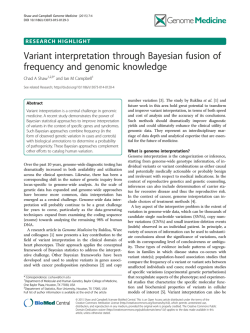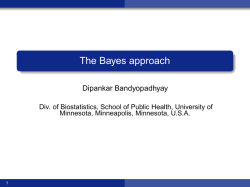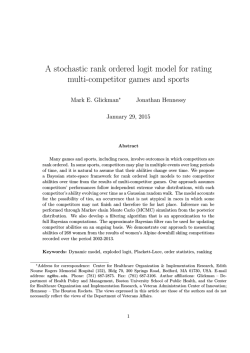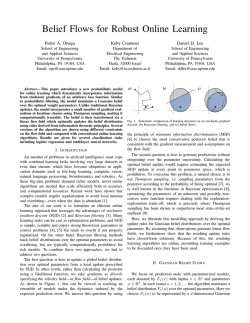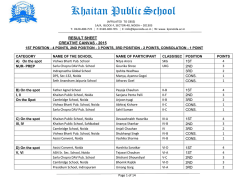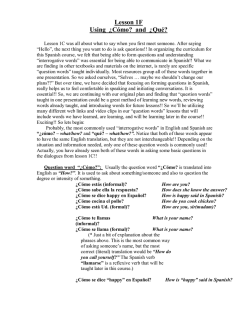
Fast and Loos...ter v.2.1
Fast & Loose: Resource-bounded Reasoning
in Wason’s
Selection
Task
1
1
2
E.J. Genot
J. Jacot
P. P¨arnamets
1
2
Theoretical Philosophy, Cognitive Science
A 4-card Poll (1): Relevance of Answers
Introduction
Relevance 1 Answers affect estimates for ms & ns ; questions can be considered
independently of one-another. (I /N: Inquirer’s/Nature’smove)
I In Wason’s Selection Task (ST) [Was68] subjects do not perform as
classical-logical reasoners.
I If ST is treated as a “loose probabilistic task” [OC94], observed
inferential behavior is optimal for Bayesian reasoners.
I [OC94] acknowledge that Bayesian computations are too complex for
bounded-rational reasoners, but no model so far.
I We obtain convergence to the Bayesian solution under assumptions
generalizing Bayesian Rationality w/ severely bounded cognitive resources.
I ?-(A, y1)
I ?-(K , y2)
N(A, [even]) N(A, [even])
ms + 1 max(ms ) − 1
max(ns ) − 1
ns + 1
N(K , [even]) N(K , [even])
I ?-(x3, 4)
I ?-(x4, 7)
N([vow], 4) N([cons], 4)
ms + 1 max(ms ) − 1
N([vow], 7) N([cons], 7)
ns − 1 max(ns ) − 1
Relevance 2 (A, y1) is always relevant (for estimating ms or ns );
(x3, 4) and (x4, 7) are possibly relevant (for ms and ns , resp.) or
irrelevant; (y2) is always irrelevant.
Relevance 3 Questions can be ordered by relevance:
Instructions for the Selection Task
“Here are four cards, all of which have a number on one side and a letter
on the other, followed by a rule that applies only to them:
A K 4 7
(Rule) If there is a vowel on the one side (P),
then there is an even number on the other side (Q)
Which card (if any) must be turned in order to decide if the rule is
true—without turning unnecessary cards?”
?-(A, y1) ?-(x3, 4) ∼ ?-(x4, 7) ?-(K , y2)
A 4-card Poll (2): General Learning Strategy
1. Relevant cards only, most relevant first.
2. I stops at fixpoint when she can solve hT , ?i based on the ratio
output Yes or No.
Components of the Model (Overview)
ms /ns , i.e.
I : ?-(A, y1)
1. Interrogative Model of Learning : generalizes Bayesian (probabilistic)
learning, captures interrogative strategies. [Hin07, GG14].
2. Non-classical semantics: subsumes truth-functional semantics [Was68] and
probabilistic semantics proved equivalent to the Bayesian model [Duc09]
3. Cooperative Principle [Gri89]: constraints the expectations based on the
instructions (generalize constraints on Bayesian priors).
N: (A, [even])
I : ?-(x3, 4)
Model (1): Interrogative Learning
N: (A, [even])
I :No
1/1
or 0/1
I : ?-(x4, 7)
N:([vow], 7)
N:([cons], 7)
N: ([cons], 4)
N: ([cons], 4)
I : ?-(·, 4)
I :Yes
I : ?-(·, 7)
I :Yes
1/0
2/0
or 2/0
or 2/1
N:([vow], 4) N:([cons], 4)
N:([vow], 7) N:([cons], 7)
I :Yes
I :No
I :No
I :Yes
2/1
1/1
1/1
1/0
I Sequential two-player game w/asymmetric info.: Inquirer (I ) vs Nature (N).
I Problem=hT , ?i: T = theory; ? = partition of models of T Mod(T ).
I N chooses a state s ∈ Mod(T ) and a set of available answers Ans.
I I must identify s ‘up to’ inclusion in some cell of Q :
. I uses ’instrumental’ questions, N answers only if in Ans.
. I stops asking questions at information fixpoints.
A 4-card Poll (3): Tie-Breakers
1. Under indifference vis-`a-vis Rule, no single best sequence:
?-(A, ·)_?-(·, 4)_?-(·, 7) ∼ ?-(A, ·)_?-(·, 7)_?-(·, 4)
Model (2): Generalized Adams Hypothesis
I Adams’ Hypothesis captures the Bayesian model of ST [Duc09]
Prob(If P then Q) = Prob(Q |P ) if
P > 0, 1 otherwise
(AH)
I Generalized Adams Hypothesis (GAH): X expects If P, then Q to
hold to the same extent that X expects Q to hold, knowing P.
2. Under assumptions of [OC94]:
(i ) Initially estimates Rule=false: not-Q is at least as likely as Q, given P.
(ii ) Questions aim at most surprising first (potential P/Q cases).
?-(A, ·) ?-(·, 4) ?-(·, 7) ?-(A, ·) ?-(·, 7) ?-(·, 4)
_
_
_
_
Conclusion: Low-Cost Rational Analysis
Model (3): Cooperative Principle
Quality Rule is true
Quantity+Relation P and Q are mentioned, not-Q is not:
(Rule∗) If there is a vowel on the one side, then there is an
even number on the other side more likely than a non-even one.
I Rule∗=true in state s iff P/Q-occurrences in s (denoted ms ) outnumber
P/not-Q occurrences in s (denoted ns ).
I With CP and pragmatic inferences, ST is solvable without computation of
probabilities/utilities or elimination of dominated strategies which are major
contributors to computational costs.
I Local reasoning is cognitively less taxing, but converges towards optimal data
selection without approximation or heuristics.
I Variations in initial attitude towards Rule/Rule∗ and criterion for picking
questions can account for relevance-based selection reversals from [GKSH01]
(future work!).
Model (4): Putting it Together
I Modeler’s representation:
Mod(T ) = {(A, y1), (K , y2), (x3, 4), (x4, 7) :
References
x
∈{A, . . . , Z } , y ∈ R} (1)
s
∈ Yes if m > n
? = {Yes, No} where =
(2)
s ∈ No otherwise
∀s ∈ Mod(T ), Ans(s ) = {a1, a2, a3, a4} &a1 = y1, a2 = y2, a3 = x3, a4 = x4 (3)
i
i
s
s
I Inquirer’s representation: linguistic competence & categorizing letters as
vowels or consonants (vow/cons) & numbers as even or not (even/even).
[Duc09] S. Duca. Rationality and the Wason selection task: A logical account. Psyche, 15(1):109–131, 2009.
[GG14] E.J. Genot and A. Gulz. The Interrogative Model of Inquiry and Inquiry Learning. To appear, 2014.
[GKSH01] Girotto, Kemmelmeier, Sperber & Van der Henst. Inept reasoners or pragmatic virtuosos? Cognition,
81(2):B69–B76, 2001.
[Gri89] H.P. Grice. Logic and conversation. In Studies in the Way of Words, pp. 22–40. Harvard U. Press, 1989.
[Hin07] J. Hintikka. Socratic Epistemology. Cambridge U. Press, 2007.
[OC94] M. Oaksford and N. Chater. A Rational Analysis of the Selection Task as Optimal Data Selection.
Psychological Review, 101(4):608–631, 1994.
[Was68] P.C. Wason. Reasoning About a Rule. Quarterly Journal of Experimental Psychology, 20(3):273–281,
1968.
[emmanuel.genot,justine.jacot]@fil.lu.se, [email protected]
© Copyright 2025
